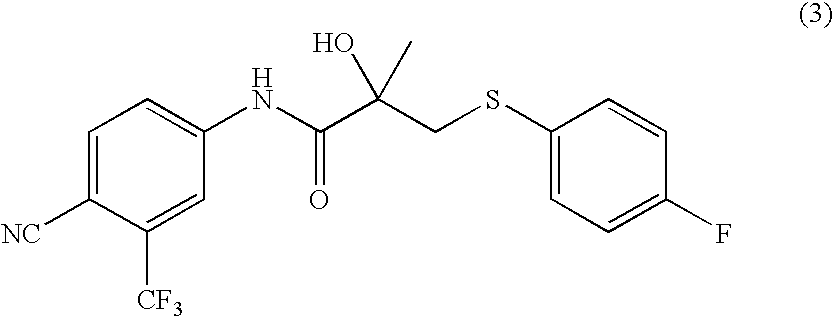Crystal of bicalutamide and production method thereof
a technology of bicalutamide and crystallization method, which is applied in the field of crystallization of bicalutamide, can solve the problems of economic burden for the cost of waste treatment after use, general harmful effects of halogenated organic solvents such as methylene chloride and the like, and achieve the effect of superior environmental benignity and safety
- Summary
- Abstract
- Description
- Claims
- Application Information
AI Technical Summary
Benefits of technology
Problems solved by technology
Method used
Image
Examples
reference example 1
Preparation of mono-perphthalic acid
[0211]Deionized water (125 ml), Na2CO3 (31.0 g, 0.25 mol) and 35% H2O2 (29.15 g, 0.3 mol) are successively charged in a 500 ml four-neck flask, and the mixture was stirred in a dry ice-methanol bath at −5° C.–0° C. Thereto was added phthalic anhydride (37.0 g, 0.25 mol) and the mixture was stirred for 30 min. The bath was removed, ethyl acetate (100 ml) was added to the mixture, and the reaction system was neutralized in a solution obtained by diluting 98% H2SO4 (15 ml) with deionized water (50 ml). After partitioning, the aqueous layer was extracted with ethyl acetate (60 ml). The obtained organic layer (0.64 g) was taken up and saturated NaI-IPA (isopropyl alcohol) solution (5 ml) and 10% acetic acid-IPA solution (20 ml) were added thereto. The mixture was boiled for 5 min. It was titrated with 0.1N aqueous sodium thiosulfate solution. As a result, mono-perphthalic acid was present in 33.5 g and the yield was 76.9%.
reference example 2
Synthesis of N-methacryloyl-4-cyano-3-trifluoromethylaniline
[0212]Using 4-cyano-3-trifluoromethylaniline and methacryloyl chloride as starting materials, the title compound is prepared according to the method described in J. Med. Chem., 1988, 954–959.
example 1
Synthesis of 4-cyano-N-(2,3-epoxy-2-methylpropionyl)-3-trifluoromethylaniline
[0213]N-Methacryloyl-4-cyano-3-trifluoromethylaniline (13.8 g, 54 mmol) and ethyl acetate (40 ml) were charged in a 300 ml four-neck flask, and the mixture was heated at 50° C.–55° C. A solution of mono-perphthalic acid in ethyl acetate (108.05 g, net 19.82 g, 110 mmol) was added dropwise at a temperature in the range of 50° C.–55° C. over 3.9 hr. After stirring at the above-mentioned temperature for 4.5 hr, a solution of mono-perphthalic acid in ethyl acetate (10.36 g, net 1.90 g, 10.4 mmol) was further added dropwise over 10 min. Then the mixture was stirred for 1 hr and left standing overnight at room temperature. The mixture was adjusted to pH=8 (universal test paper) with 20% aqueous KOH solution and partitioned. The organic layer was washed with deionized water (20 ml) in which Na2S2O5 (5.0 g) had been dissolved, dried over MgSO4, decolorized with activated carbon (carborafine 0.5 g), and concentrated...
PUM
| Property | Measurement | Unit |
|---|---|---|
| temperature | aaaaa | aaaaa |
| temperature | aaaaa | aaaaa |
| temperature | aaaaa | aaaaa |
Abstract
Description
Claims
Application Information
 Login to View More
Login to View More - R&D
- Intellectual Property
- Life Sciences
- Materials
- Tech Scout
- Unparalleled Data Quality
- Higher Quality Content
- 60% Fewer Hallucinations
Browse by: Latest US Patents, China's latest patents, Technical Efficacy Thesaurus, Application Domain, Technology Topic, Popular Technical Reports.
© 2025 PatSnap. All rights reserved.Legal|Privacy policy|Modern Slavery Act Transparency Statement|Sitemap|About US| Contact US: help@patsnap.com



